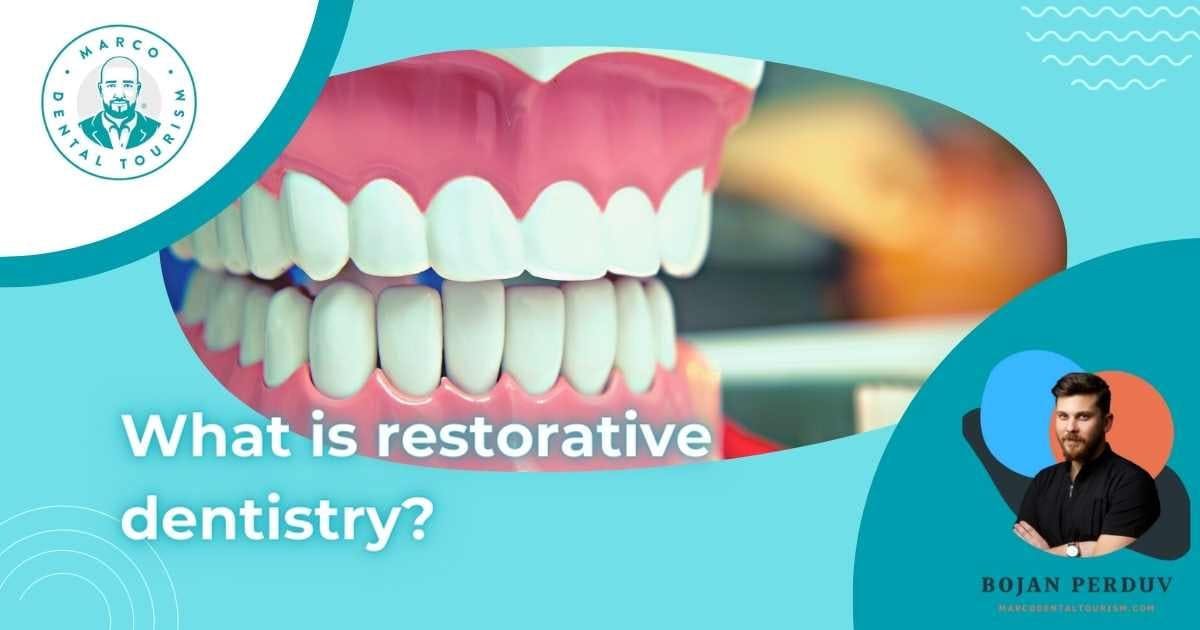Restorative Dentistry

Introduction to restorative dentistry
In this blog, we talk about restorative dentistry and provide information on how this specialized area of dentistry can help us restore damaged teeth, improve tooth function, and improve overall oral health.
What is restorative dentistry?

Restorative dentistry is a branch of dentistry that focuses on restoring the function and appearance of damaged teeth. It includes procedures such as fillings, crowns, bridges, and dental implants. Restorative dentistry can help achieve natural smile beauty and long-term dental health.
What are the advantages of restorative dentistry?
Restorative dentistry can improve the function, appearance, and health of damaged teeth. Benefits include restored ability to chew, improved speech, and reduced risk of further decay or damage.
How do restorative procedures differ from aesthetic procedures?
Restorative dental procedures aim to restore the function and structure of teeth damaged by caries, injury or dental disease. In contrast, aesthetic or cosmetic procedures improve the appearance of teeth with treatments such as teeth whitening, veneers, and orthodontic procedures.
Who can benefit from restorative dentistry?

Restorative dentistry can benefit anyone who needs to repair or restore damaged, decayed or missing teeth. This includes people with cavities, tooth fractures, missing teeth, or other oral health problems that affect the functionality and appearance of their teeth.
What are the common restorative dental procedures?

Common restorative dental procedures include dental fillings, crowns, bridges, and implants. Fillings restore teeth affected by caries, while crowns, bridges and implants replace missing teeth.
What are dental fillings and what types of fillings are there?

Dental fillings are materials used to restore teeth damaged by caries or injury. There are different types of fillings including amalgam, composite, ceramic and gold. The recommended type of dental filling depends on the place and severity of damage, price and personal preferences.
What are the advantages and disadvantages of different dental materials?
Dental materials differ in durability, aesthetics and biocompatibility. Composite resins are aesthetically pleasing but may require more maintenance, while amalgam fillings are durable but less attractive. Talking to the dentist helps in making the best decision for the patient's needs.
What is a dental crown and how is it placed?

A dental crown is a cap that covers the entire visible part of the tooth in order to restore its size, shape, function and appearance. The procedure for placing a dental crown usually involves preparing the tooth and cleaning it from caries, then taking impressions and finally cementing the crown onto the tooth.
What are dental bridges and what is the procedure for placing a bridge?

A dental bridge is a fixed restoration used to replace one or more missing teeth. The procedure involves preparing the surrounding teeth for dental crowns, which serve as support for the bridge. The bridge is then manufactured and cemented into place, restoring the function and aesthetics of the teeth and jaw.
What are dental implants?

Dental implants are artificial tooth roots that provide a permanent foundation for fixed or removable replacement teeth. They are usually made of titanium and are surgically placed in the jawbone to replace missing teeth. Implants are a permanent, completely natural-looking alternative to missing teeth.
What does recovery look like after a restorative procedure?

After a restorative procedure, recovery may include mild discomfort, swelling, and sensitivity to heat and pressure. Patients should rest, avoid hard and sticky foods, and practice good oral hygiene. Subsequent examinations will monitor the healing and recovery of the affected area.
How to maintain teeth after restorative procedures?

After the restorative procedure, rinse your mouth with warm salt water to reduce swelling and promote healing. Avoid hard food for a few days and drink plenty of fluids. Gently clean the area around the affected tooth and visit your dentist regularly to monitor the progress of recovery.
How to maintain hygiene after installing dental implants?
During recovery, it is important to rinse your mouth with salt water and avoid hard and chewy foods. It is also important to keep the mouth hydrated, which is why regular fluid intake is recommended. For a successful recovery, it is crucial that you follow all the instructions prescribed by the dentist.
What is oral surgery and how does it help in tooth restoration?

Oral surgery is a specialized area of dentistry that includes surgical procedures for the diagnosis, treatment, and restoration of teeth and jawbones. It helps in repairing damaged teeth, removing impacted teeth and correcting misalignment of the jaw, restoring the functionality and better appearance of the teeth.
What is endodontic therapy?

Endodontic therapy is a dental treatment commonly referred to as root canal therapy. It involves removing infected or damaged tissue from inside the tooth, cleaning the area, and filling it with a special material. The procedure aims to save the tooth and relieve pain caused by infection or inflammation.
When is endodontic therapy necessary?
Endodontic therapy is necessary when the pulp inside the tooth becomes infected or inflamed. This can happen due to tooth decay, trauma, or permanent damage to the tooth. Symptoms may include swelling, severe pain, and sensitivity to hot and cold.
What is periodontitis and how is it treated?
Periodontitis is a severe form of gum disease that damages the tissue and bones that support the teeth. It is treated with professional cleaning and deep scaling, antibiotics, and, in severe cases, surgery. The onset of periodontitis can be prevented by good oral hygiene and regular dental examinations.
What are the types of dental prosthetics and when are they recommended?

The most common types of dental prosthetics are dentures, bridges and implants. Dentures are recommended for patients who are missing all or most of their teeth, bridges are suitable for those who are missing one or two teeth. Implants are installed in patients who have lost one or more teeth and want a long-term replacement.
Our conclusion

As we have already stated, restorative dentistry is a vital aspect of modern dentistry that has revolutionized the way we approach dental health. Regardless of whether you have a damaged tooth, a missing tooth, or any other dental problem, restorative dentistry has the necessary techniques that will restore your smile to its former glory.



















Share your opinion!
What do you think about this topic?
Comments (0)